Creating your own cedar perfume at home this season lets you craft a unique signature scent while saving money. You'll enjoy the warm, woody notes of cedar mixed with your choice of complementary fragrances, using natural ingredients you can trust. Working with cedar's versatile base notes allows you to customize the perfect balance of forest-inspired aromas for fall and winter wear. Discover how this timeless scent can transform your personal fragrance collection.
The Natural Charm of Cedar Fragrances
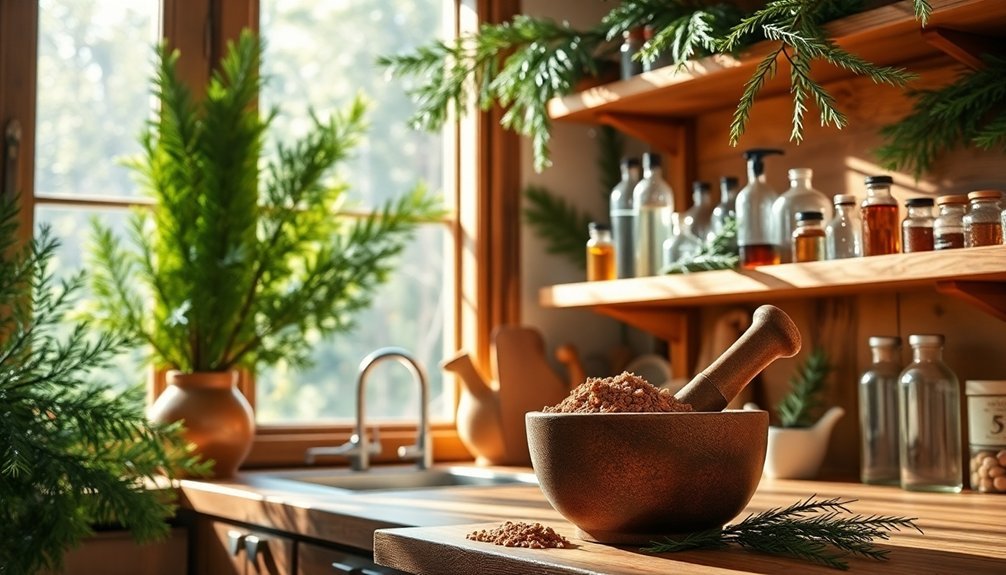
When you first encounter cedar's distinctive aroma, you'll discover a complex blend of woody, fresh, and spicy notes that transport you to a serene forest setting. This timeless scent carries hints of pine and soil, reminiscent of freshly sharpened pencils, while offering subtle variations across different cedar varieties like Virginia, Atlas, and White Cedar.
You'll find cedar's charm lies in its versatility and staying power. Whether it's adding warmth to floral compositions or depth to fruity fragrances, cedar works beautifully as a base note that grounds your perfume. The scent offers a powdery soft quality that adds refinement to any fragrance blend.
It's no wonder prestigious brands like Chanel, Hermès, and Maison Francis Kurkdjian feature cedar in their signature scents. Beyond its appealing aroma, you'll appreciate cedar's natural properties, including its ability to neutralize unwanted odors and provide soothing benefits.
Essential Tools and Ingredients for Cedar Perfume
Creating cedar perfume at home starts with gathering the right tools and essential ingredients.
You'll need glass mixing beakers, a 1oz tinted jar, a small funnel, whisk, and coffee filter for the preparation process.
For your signature scent, you'll want to layer three distinct notes.
Start with base notes of cedarwood, vanilla, vetiver, ylang ylang, and frankincense.
Build the middle layer using rose, lavender, blue chamomile, geranium, and benzoin essential oils.
Top it off with bright citrus notes from bergamot, lemon, orange, and grapefruit oils.
Don't forget the perfumer's alcohol or pure grain alcohol – it's vital for blending and preserving your creation.
Track your measurements in a dedicated journal to replicate successful blends in the future.
With these tools and ingredients ready, you're set to craft your unique cedar perfume.
Selecting Quality Cedar Essential Oils

When selecting cedar essential oils for your homemade perfume, you'll need to choose between pure oils and pre-diluted options, with pure oils offering more control over your final formulation.
While Atlas Cedar is prized for its unique properties, its endangered status means consumers should carefully verify their supplier's sustainability practices.
Texas Cedarwood oil, with its high cedrol content of 35-48%, delivers a stronger aroma than Virginiana or Chinese varieties, which contain less cedrol.
You'll want to verify the specific cedar species listed on the label, as Atlas Cedar provides sweet, floral notes while Himalayan Cedar offers unique compounds like himachalenes and deodarone.
Pure Vs Diluted Options
As you explore the world of cedar essential oils, understanding the difference between pure and diluted options becomes crucial for achieving the best results in your home perfumery.
Pure cedar oils offer superior therapeutic benefits and a more potent, consistent aroma that'll enhance your perfume creations. While they're initially more expensive, they provide better value through their concentrated potency and reliable quality.
When selecting your cedar oil, consider these key differences:
- Pure oils maintain their natural properties and deliver more effective therapeutic benefits.
- Diluted options often contain additives that can compromise the oil's natural benefits.
- Pure oils offer a stronger, more authentic aroma that'll last longer in your perfume.
Always check the brand's reputation and transparency about their sourcing methods to verify you're getting a genuine pure cedar essential oil for your perfume-making journey.
Know Your Cedar Species
The vast world of cedar species offers distinct aromatic profiles that can dramatically impact your homemade perfumes.
If you're seeking a woody-sweet scent, Atlas cedarwood's sharp notes might be your perfect match. For mature, smoky undertones, you'll want to explore Virginian cedarwood, which blends beautifully with florals and patchouli.
White cedar provides a gentler option with its floral character and violet undertones, making it ideal for softer compositions.
If you're after bold intensity, Texas cedar delivers fiery, dry wood notes that'll make a statement in your blend.
When selecting your cedar oil, consider its origin's environmental factors. Trees grown in cooler climates or at higher altitudes often yield more potent oils, while soil composition directly affects the oil's quality and aromatic complexity.
Understanding Cedar's Role as a Base Note
Base notes form the foundation of any perfume, and cedar stands as one of the most revered among them.
You'll find cedar's distinctive aroma brings warmth and depth to your homemade perfume while providing exceptional staying power. Its woody, fresh, and slightly spicy scent profile will anchor your composition beautifully.
When you're crafting your cedar-based perfume, remember these key benefits:
- Cedar balances both floral and fruity notes, making it versatile for various fragrance combinations.
- You'll get that timeless, elegant quality that's reminiscent of high-end perfumes.
- Your creation will have impressive longevity thanks to cedar's natural staying power.
Cedar's rich history in perfumery and its soothing properties make it an excellent choice for your DIY fragrance project.
Its ability to harmonize with other base notes like sandalwood and patchouli offers endless creative possibilities.
Blending Cedar With Complementary Scents
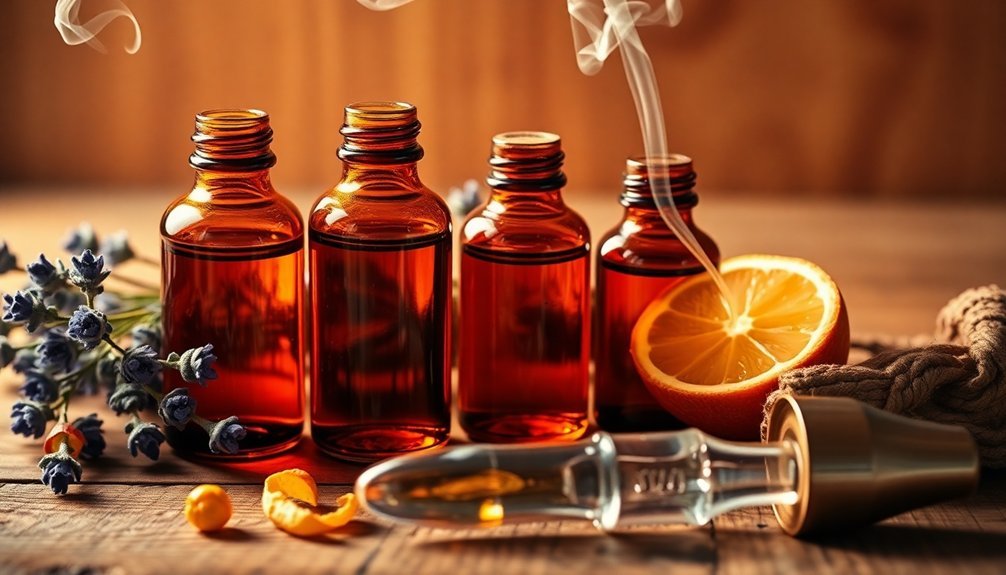
Creating your perfect cedar-based fragrance depends on understanding which scents harmonize best with this versatile wood note.
You'll find cedar pairs beautifully with other woody scents like sandalwood, vetiver, and patchouli to create rich, warm fragrances. For a more complex profile, try adding resinous notes like balsam or benzoin, which bring sweet and spicy dimensions to your blend.
If you're seeking a lighter touch, combine cedar with florals like rose or sweet peas, or experiment with fruity notes such as plum or citrus.
These combinations work particularly well in creating balanced, sophisticated scents. The best part? Cedar-based blends are seasonally versatile, so you can enjoy your creation year-round, whether you're making a personal perfume, room spray, or scented candle.
Safety Precautions and Dilution Guidelines
Since working with essential oils requires careful attention to safety, understanding proper dilution ratios and handling procedures is crucial for creating cedar perfumes at home.
When working with cedar oil, you'll need to follow proper dilution guidelines, using perfumer's alcohol or a carrier oil as your base. For a safe and effective cedar perfume, never exceed a 10% dilution rate.
Here's what you'll need to remember for safe cedar perfume creation:
- Always perform a patch test by applying a drop of your diluted blend to a testing strip and watching for reactions over 48 hours.
- Store your cedar perfume in dark glass bottles, away from sunlight and heat, with the rubber dropper removed.
- Keep your workspace well-ventilated and your materials out of reach of children and pets.
Creating Your Signature Cedar Formula

When developing your signature cedar perfume, you'll discover that the art lies in balancing proportions and selecting complementary notes.
Start by defining your fragrance concept – whether you want a light, airy scent or a deep, sensual aroma. Choose ingredients that harmonize with cedar's woody profile, such as patchouli, sandalwood, or vetiver.
Test your combinations using scent strips, keeping the cedar essence between 20-30% of your total formula.
You can create unique accords by pairing cedar with amber for warmth, vanilla for sweetness, or citrus for freshness.
Draw inspiration from successful perfumes like Terre d'Hermès or Byredo Super Cedar, which showcase cedar's versatility.
Remember to evaluate and adjust your formula until you achieve your desired olfactory profile.
Storage and Aging Your Cedar Perfume
Proper storage and aging techniques play an essential role in preserving your cedar perfume's quality and enhancing its aromatic profile. Since cedar notes are relatively stable, you'll find they age beautifully when stored correctly.
Keep your creation in its original bottle with a tight-fitting cap, away from direct sunlight and heat sources.
For ideal preservation and maturation of your cedar perfume:
- Store your blend in a cool, dark drawer or cabinet where temperatures remain steady around 41°F.
- Don't transfer your perfume to decorative bottles, as they mightn't seal properly and can lead to unwanted oxidation.
- Allow your blend to mature for several weeks in proper storage conditions, letting the cedar notes fully merge with other ingredients.
Tips for Achieving the Perfect Balance
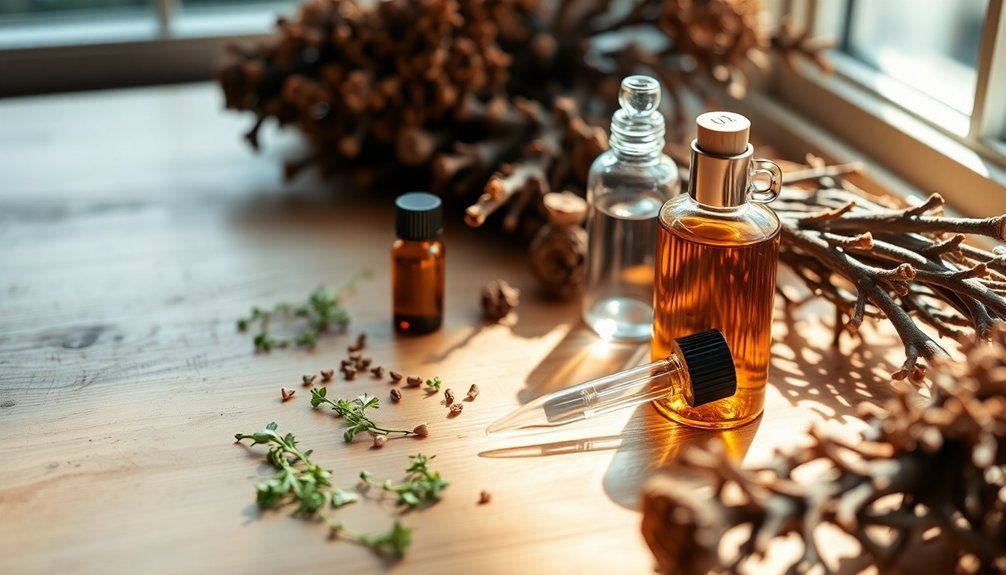
Creating a well-balanced cedar perfume requires careful attention to both ingredient ratios and olfactory harmony.
Start by following the 30-50-20 rule: 30% top notes, 50% middle notes, and 20% base notes, with cedar serving as your base note foundation.
When blending, you'll want to pair your cedar with complementary scents.
Try citrus or floral top notes like bergamot or sweet pea, while incorporating middle notes that bridge the gap between your lighter top notes and woody base. Sandalwood and vetiver work beautifully with cedar for added warmth and depth.
Don't rush the process – let your blend sit for several days to allow the notes to meld together.
You can adjust the ratios as needed until you've achieved your desired fragrance profile.
Common Mistakes to Avoid When Blending
When making cedar perfume, you'll need to measure your ingredients precisely to avoid a muddled or overwhelming blend.
If you're working with cedarwood oil, it's especially important to use smaller amounts since it can easily overpower other fragrances in your mixture.
You can start with a ratio of one part cedarwood to two parts of your complementary oils, adjusting as needed based on your test results.
Proper Measurements Matter Most
The success of your cedar perfume hinges on three critical measurement factors: precision, consistency, and balance.
When you're working with cedar essential oil, even small measurement errors can drastically affect your final fragrance. You'll need to be particularly mindful of your ratios when blending with perfumer's alcohol to achieve the right concentration.
- Use proper measuring tools like pipettes or droppers to guarantee exact amounts – eyeballing won't cut it and could lead to overdosing.
- Start with small test batches using blotter strips to assess the cedar's interaction with other notes before scaling up.
- Document your measurements meticulously – if you create something amazing, you'll want to replicate it perfectly next time.
Balance Essential Oil Ratios
Now that you've mastered precise measurements, let's focus on balancing your ratios – a common stumbling block for many perfume makers.
When creating your cedar perfume, you'll want to follow the 3:5:2 ratio for top, middle, and base notes, but don't feel locked into this formula. Trust your nose and adjust accordingly.
Watch out for the temptation to add "just one more drop" – this can quickly throw off your carefully crafted blend.
Remember to take breaks between testing to avoid olfactory fatigue, which can skew your perception. You'll also want to stick to glass containers for mixing and storing your creation, as some essential oils can react with plastic.
Keep your eyes protected by maintaining a safe distance while blending your cedar masterpiece.
Enhancing Longevity of Your Cedar Perfume
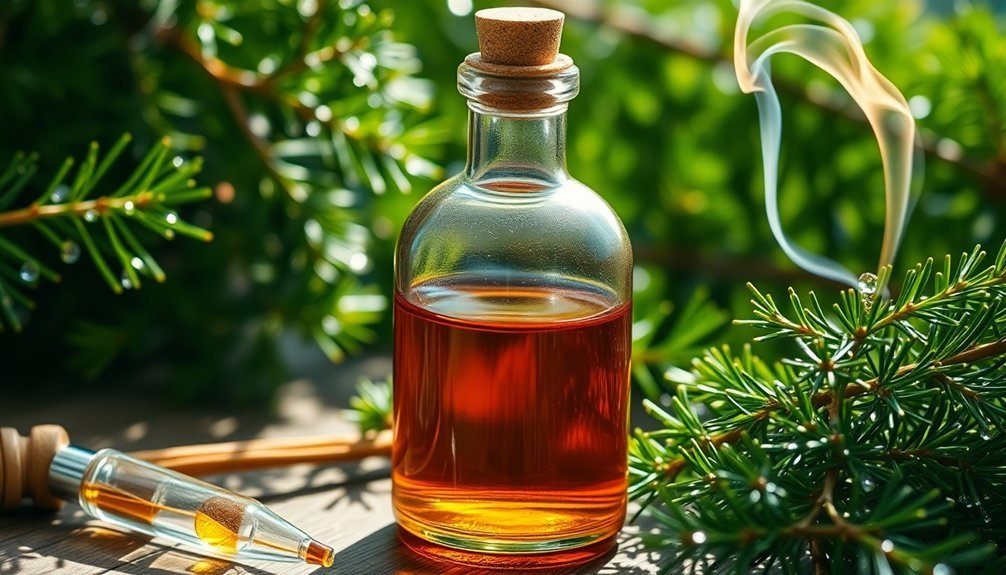
Making your cedar perfume last longer requires understanding several key factors that influence fragrance longevity. Since cedar belongs to the woody note family, you're already starting with a naturally long-lasting scent.
However, you can enhance its staying power by properly preparing your skin and using effective application techniques.
- Moisturize your skin before applying the perfume – this creates a natural barrier that helps lock in the scent.
- Apply your cedar perfume to pulse points right after a warm shower when your pores are open.
- Layer your fragrance by using complementary cedar-scented products like body lotion or oil.
You'll also want to avoid rubbing your wrists together after application, as this breaks down the fragrance molecules.
Instead, gently dab the perfume and let it naturally settle into your skin.
Seasonal Variations in Cedar Blends
Just as your cedar perfume's longevity changes throughout the day, its character can transform with each passing season.
You'll find endless possibilities to adapt your cedar blend throughout the year. In winter, warm up your scent with cinnamon and clove, or create a cozy indoor atmosphere by adding vanilla and musk.
When spring arrives, lighten your blend with fresh florals like lilac or jasmine, and incorporate citrus notes for brightness.
Fall calls for harvest-inspired combinations – try mixing cedar with apple and sweet orange, or add earthy patchouli for grounding.
You can even travel the world through scent by incorporating exotic elements like Indian cardamom or tropical lemongrass.
Each season offers unique opportunities to reinvent your cedar perfume while maintaining its signature woody base.
Testing and Adjusting Your Final Creation
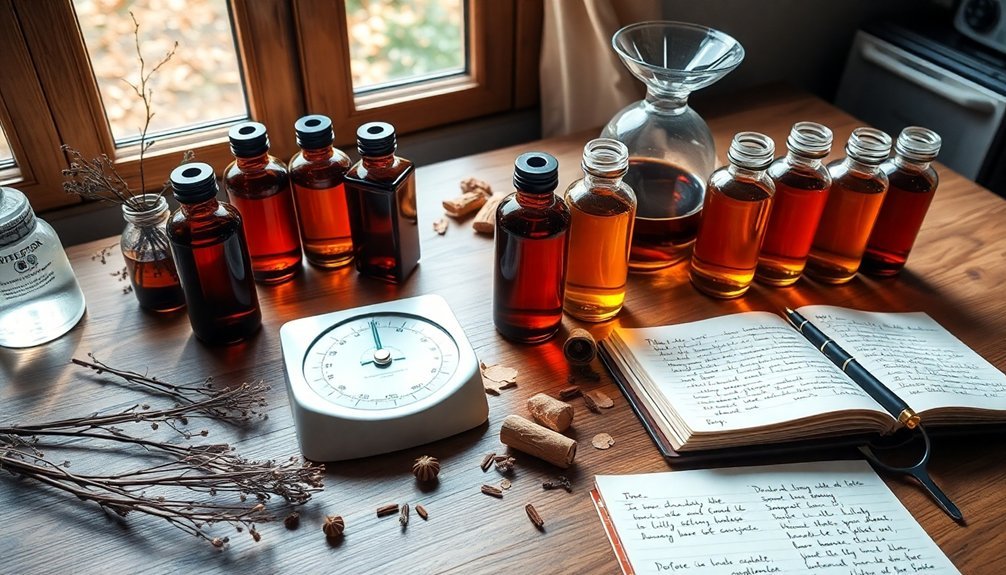
You'll need to carefully test your cedar perfume over several hours to understand how the scent develops from its initial spray to its final base notes.
Track and record your observations at specific intervals, paying close attention to how the cedar interacts with other ingredients during each phase of development.
Based on your findings, you can adjust the proportions of your ingredients until you achieve your desired scent profile, making sure to document the exact measurements of your successful formula.
Evaluating Scent Over Time
Once you've created your cedar perfume, proper examination over time becomes essential to guarantee its success.
You'll need to monitor how the scent evolves through its three distinct phases: top notes, middle notes, and base notes.
- Start by evaluating the initial impression within the first few minutes, checking if the cedar presents a fresh, woody character while harmonizing with other top notes like citrus.
- Watch how the scent shifts into heart notes after 30 minutes, ensuring the cedar supports floral or fruity elements without overpowering them.
- Finally, assess the base notes over several hours to confirm the cedar maintains its woody essence while balancing with deeper elements like amber or patchouli.
Make adjustments based on your observations, and repeat the testing process until you're satisfied with the results.
Fine-Tuning Formula Proportions
After evaluating your perfume's scent development, the next step involves refining the formula proportions to achieve your ideal cedar fragrance. You'll need to adjust the ratios based on your desired perfume type and strength.
| Perfume Type | Essential Oil Ratio |
|---|---|
| Parfum | 20-30% oils |
| Eau de Toilette | 5-10% oils |
| Cologne | 3-5% oils |
| Custom Blend | Adjustable |
Start with small test batches, using 1-4 drops of cedarwood per 30ml of carrier agent. If you're using perfumer's alcohol, maintain a 20-80% ratio of oils to carrier. For a milder option, try jojoba or sweet almond oil. Don't forget to filter your final creation through a coffee filter and let it mature for several weeks in a cool, dark place to enhance the blend's stability.
Documenting Your Preferred Ratios
Keeping detailed records of your cedar perfume experiments forms the foundation for creating a signature scent that's both repeatable and refinable. Document your fragrance journey by noting how each layer unfolds on your skin and tracking the ratios that work best for your body chemistry.
To maintain accurate records of your cedar perfume creation:
- Track the exact measurements of each ingredient, including top notes like bergamot, heart notes that complement cedar, and base notes that enhance its woody character.
- Record how the scent evolves over 30-minute intervals, paying attention to which notes become more prominent.
- Note the storage conditions that preserve your perfume's quality, such as keeping it in a cool, dark place.
Test your creation on both blotters and skin, adjusting the formula until you've achieved your ideal cedar fragrance.
Frequently Asked Questions
Can People With Nut Allergies Safely Use Cedar Perfume?
Yes, you can safely use cedar perfume if you have nut allergies. Cedar perfume doesn't contain nut proteins, and there's no cross-reactivity between cedar and nuts. Still, do a patch test for general fragrance sensitivity.
Does Homemade Cedar Perfume Stain Clothes or Fabrics?
When properly diluted, your cedar perfume shouldn't stain fabrics. However, you'll want to test it on a small hidden area first and use alcohol as a base to prevent any potential staining issues.
How Do Different Weather Conditions Affect Cedar Perfume's Scent Projection?
You'll notice your cedar perfume projects strongly in warm, humid weather due to increased evaporation and moisture. In cold, dry conditions, it'll stay closer to your skin and may require reapplication more frequently.
Can Cedar Perfume Attract or Repel Certain Animals?
Your cedar perfume will repel most insects like ticks, mosquitoes, and fleas due to its natural oil properties. It disrupts pests' pheromones and can dehydrate their exoskeletons, while remaining safe for humans and pets.
Is Cedar Perfume Safe to Wear During Pregnancy?
You shouldn't wear cedar perfume during pregnancy due to its high ketone content and potential risks. The compounds can cross the placenta and blood-brain barrier. Consult your healthcare provider for safer fragrance alternatives.
In Summary
You'll find that making cedar perfume at home connects you deeply with nature while giving you full control over your signature scent. Whether you're creating a cozy winter blend or a fresh summer fragrance, your homemade cedar perfume offers a unique, sustainable alternative to commercial options. Don't hesitate to experiment with different complementary notes until you've crafted the perfect personal scent that tells your story.

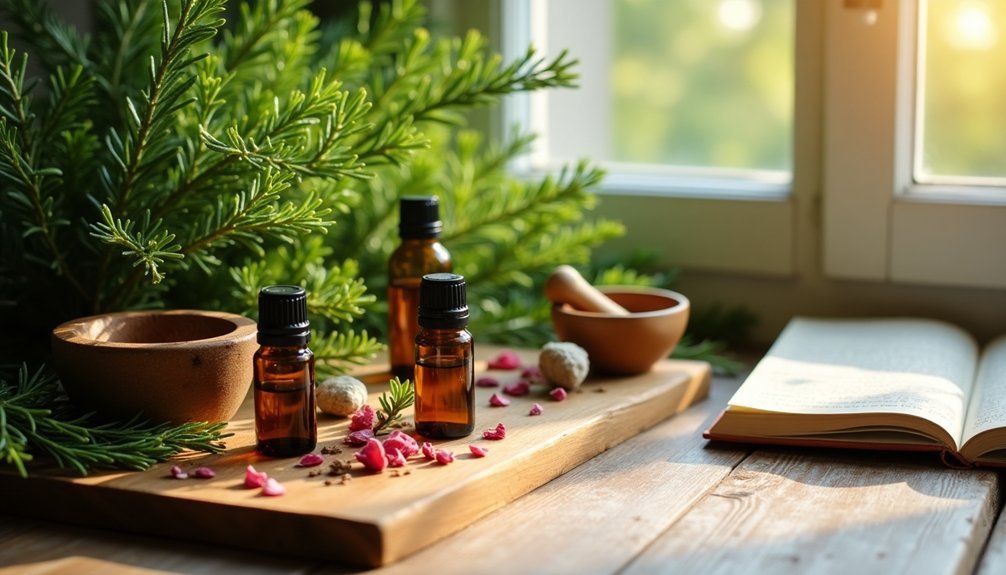



Leave a Reply